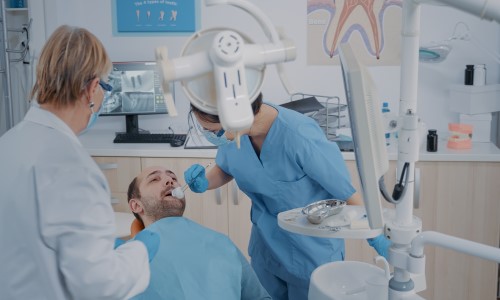Teeth extractions are performed on teeth that have been damaged beyond repair or those that will harm the patient’s life. Extractions may also be performed to equilibrate the jaws better and provide a better fit of dentures.
Tooth extraction is done by an oral surgeon, often under local anesthesia within the mouth itself. The use of sedatives and general anesthesia is not every day, as they can lead to excessive bleeding, further complicating the patient’s treatment. In some cases, however, depending on the severity of tooth decay/damage/pain, there may be no other option but to sacrifice a minimal amount of healthy gingiva if it means saving vital structures such as bone and nerves nearby. 
A tooth can be considered irreversibly damaged when its pulp is exposed to trauma, caries, or periodontal disease. This means that the blood supply to the tooth has already been lost, and, in most cases, the entire infected tissue must be removed. After extraction of an irreversibly damaged tooth, implantation is impossible because of irreversible damage to the surrounding bone structures.
For less severe cases causing pain but not exposing the pulp, a pulpectomy may treat this level of damage and save it from extraction. However, after holding a tooth with this procedure, there is still a chance that the patient will need the tooth extracted down the road if they continue to have dental issues such as decay/infection. If the tooth is still in good condition and not causing any pain or damage, it can be restored to prevent further problems.
Potential risks and complications of extractions include:
The desired result of tooth extraction is removing the source of pain or pathology. It also prevents further damage to surrounding teeth and bone if the tooth is severely injured. Several different extractions can be performed depending on what teeth need to be removed and the patient’s age and overall health. All extractions require an evaluation by a dentist who will determine what type, how many and which teeth will need to be extracted. A proper diagnosis must be made before any treatment starts, as some causes may lead to more extensive treatment rather than simply extracting one or two teeth.
Extractions are commonly referred to as simple (one tooth), surgical (more than one tooth), or partial (below the gingiva, not visible in the mouth). The type and how many teeth will be removed are also determined by patient age and overall health. However, extractions are often performed when a cavity has destroyed too much of a tooth to be restored with a filling.
The dentist may consider preserving an impacted third molar if it’s still partially erupted and there is sufficient room for future placement of implants or other restorative work. The wisdom tooth may also not need to be extracted if it can be saved with orthodontics instead of surgery.
Tooth extraction can be used to treat any number of dental issues such as:
There are three different types of tooth extraction. They are called simple, surgical, and partial. Every kind of extraction works to remove one or more teeth from the mouth for various reasons.
The simplest way to extract a tooth is by using forceps, which are sometimes used when there isn’t enough room in an arch to use other methods that might be more appropriate. To be specific, the simple/manual technique of extraction is accomplished with a pair of dental forceps or elevators, which can be used to grasp the tooth near its tip. At the same time, another instrument breaks away some bone above the tooth’s tip so it can slip under the alveolar bone margin, where it can then be rotated out.
A labyrinthectomy is not used to extract a tooth but to expose the root of a partially erupted impacted tooth. These procedures are often used when removing the tooth doesn’t require any surgery and can be taken care of during one office visit. The doctor will numb the patient’s mouth before extracting so they won’t feel anything during this process.
Who should get teeth extractions?
Extractions are used to treat any problem related to teeth, such as disease or trauma. For example, if a cavity has eaten away enough of the tooth that it cannot be restored with a filling, the dentist may recommend extraction over other treatment methods. An extraction may also be recommended if the gum around one or more teeth is inflamed and causing pain. They are also advised when wisdom teeth become impacted in the mouth, which can cause problems later on.
Extraction is usually not recommended for baby teeth because there are still years left to fall out naturally. Still, sometimes they might need to be removed sooner due to decay or crowding that causes harm to surrounding teeth or jaws. People who grind their teeth at night should have their molars pulled so they won’t continue to cause damage.